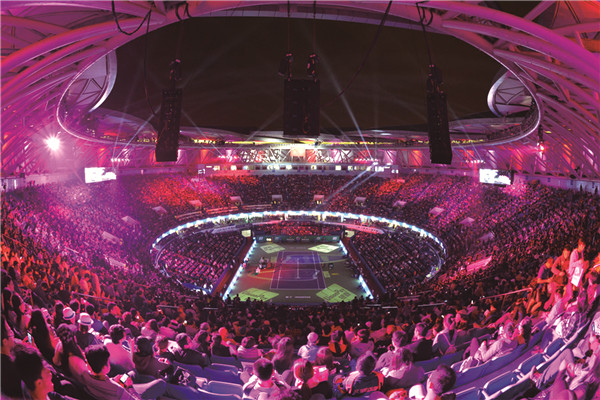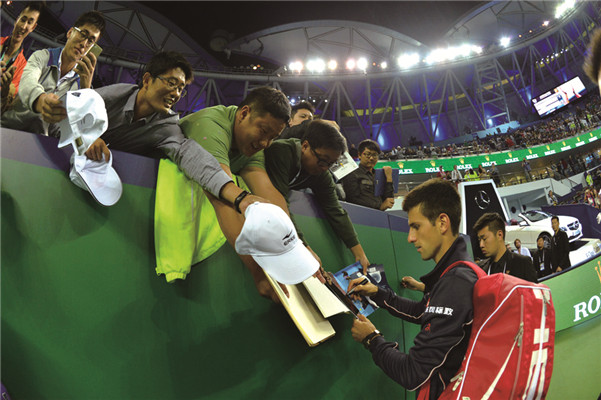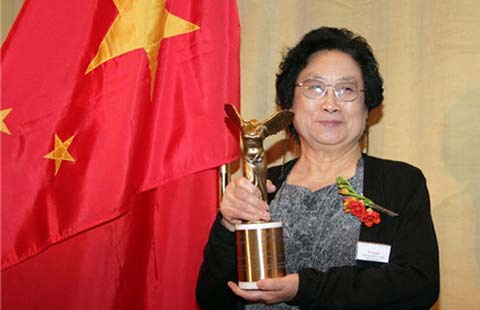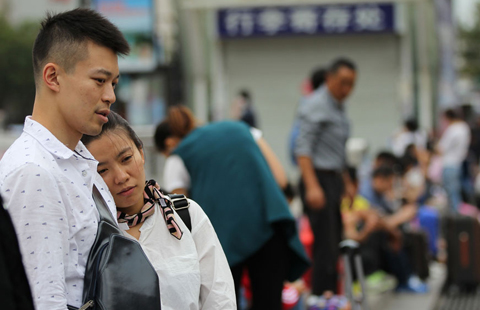Shanghai Rolex Masters rides new enthusiasm for tennis
Updated: 2015-10-10 03:46
By Zhang Kun in Shanghai(China Daily USA)
|
||||||||
 |
|
The Shanghai Rolex Masters has attracted top tennis players every year as well as an increasing number of local tennis fans. PROVIDED TO CHINA DAILY |

The professional tennis tournament has significantly accelerated the popularity of the sport of tennis among the public in Shanghai.
Tennis seems to have developed in China faster than virtually anywhere else on the global scene, said Li Yao, vice-director of the Shanghai Tennis Association.
Every year between September and October, the world’s top players fly to Asia for the China Open tournament in Beijing or the Tokyo Open in Japan, before meeting up in Shanghai for the climax of the Asian tennis season, at the Shanghai Rolex Masters.
The Shanghai Rolex Masters is chronologically the eighth out of nine ATP World Tour Masters 1000 tournaments on the Association of Tennis Professionals (ATP) World Tour season, and is the only one played outside of Europe and North America.
For five years in a row, from 2009 to 2013, the Shanghai Rolex Masters was named the best tournament by voting of the athletes. “Our ambition now is to win the title back,” said Patrick Yang, the vice-general manager of Shanghai Juss Event Management Co, Ltd, the tournament organizer.
Shanghai hosted the first international professional tennis tournament in China in 1998. It was a bold move for Juss, a new company dedicated to tennis games, which paid the handsome amount of $1.25 million for the right to host the Heineken Open, a 250-point-ranked tournament. “Shanghai had no more than 10,000 tennis players at that time,” Yang said. “But a consumers’ survey showed that tennis was the first choice that sports enthusiasts were ready to take up.”
Star athletes of the time, such as Andre Agassi and Michael Chang, all played the Heineken Open in Shanghai.
The success encouraged Juss to host the ATP final of 2002, when the eight top-ranking athletes competed in Shanghai.
It was also the time when Shanghai applied to host the World Expo 2010, and the tournament successfully drew lots of positive attention for the city.
Shanghai went on to hold the ATP final from 2005 to 2008. Public interest in the game grew significantly during this time. A survey in 2005 showed that 540,000 people were playing tennis regularly in Shanghai, Yang said. “In 2012, the number grew to nearly 1 million.”
The Shanghai Rolex Masters started in 2009. “We are still the one and only ATP Masters 1000 tournament in Asia,” Yang said. “Every year the Asian leg of the ATP world tour consists of three tournaments: both the China Open in Beijing and the Tokyo Open are ATP World Tour 500 series, and Shanghai is a Masters 1000 event.” There are altogether nine tournaments in the Masters 1000 series around the world every year. They are the second-most important tennis events behind the four Grand Slam tournaments.
The China Open in Beijing has grown rapidly in the past few years, mainly because of its importance in the women’s tournament, especially as China has produced a few highly successful women players.
“Stars play such an important role in the promotion of tennis,” Li said. Whenever Li Na, the first Chinese woman tennis player to win a Grand Slam, played in a tournament, the TV ratings would surge.
“In the short period after Li Na’s retirement, the public interest for tennis in China surely has cooled down a little bit,” Yang said. “But in the long run, the trend is still going strong.”
Professional tennis is a new thing in China. Traditionally, athletes in China are selected at a very young age and start systematic training in sports schools. The funding is completely sponsored by the state, and known as the national strategy in training top athletes and Olympic champions. Now with the sport’s strong marketing development here, corporations are beginning to invest in tennis training.
Shanghai’s municipal professional tennis team was founded in this context, and has about 30 players now. Wu Di, the most acclaimed of them, has won several national championships and is competing in international tournaments now.
Half of the universities and colleges in Shanghai have tennis clubs or provide tennis class in their sports curriculum, Li said. Every year hundreds of tennis tournaments take place all over the country.
Many parents in China, inspired by Li Na, have led their children to begin training in tennis. The Internet has also played an important part, bringing together people of the same interest. “There are no less than 100 tennis clubs in Shanghai, and the most popular of them have up to 1,000 members,” Li said.
The popularity of tennis doesn’t immediately lead to good performance on the professional tennis court. “We still have a long way to catch up: our management system, coaches training, and national tournaments…all need to improve, and these are the framework that guarantees the production of good athletes,” Li said.

 Top 10 most competitive economies
Top 10 most competitive economies
 Cold wave sweeps through China
Cold wave sweeps through China
 Taking a peek
Taking a peek
 News you don't wanna miss over the National Day holiday
News you don't wanna miss over the National Day holiday
 TCM knacks to fight post-holiday syndrome
TCM knacks to fight post-holiday syndrome
 Zhang Lei wins fourth season of Voice of China
Zhang Lei wins fourth season of Voice of China
 Travel rush around China as National Day holidays end
Travel rush around China as National Day holidays end-
 Rising yuan use may lift IMF basket prospects
Rising yuan use may lift IMF basket prospects
Most Viewed
Editor's Picks

|

|

|

|

|

|
Today's Top News
Tu first Chinese to win Nobel Prize in Medicine
Huntsman says Sino-US relationship needs common goals
Xi pledges $2 billion to help developing countries
Young people from US look forward to Xi's state visit: Survey
US to accept more refugees than planned
Li calls on State-owned firms to tap more global markets
Apple's iOS App Store suffers first major attack
Japan enacts new security laws to overturn postwar pacifism
US Weekly

|

|







